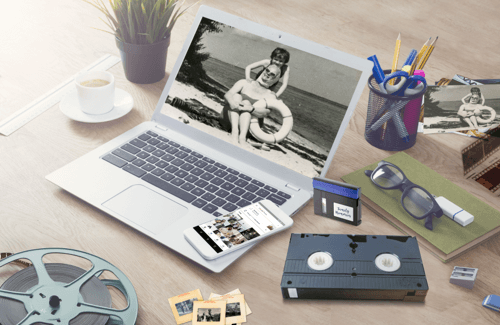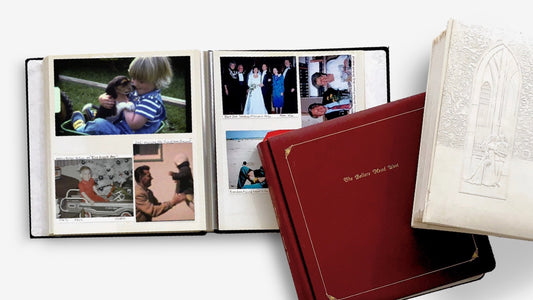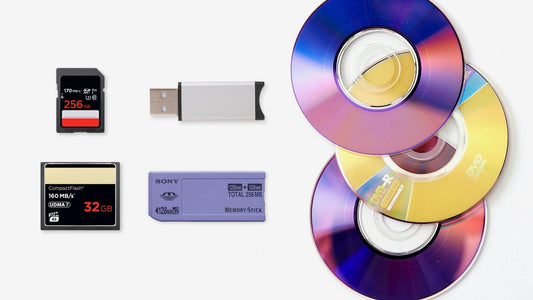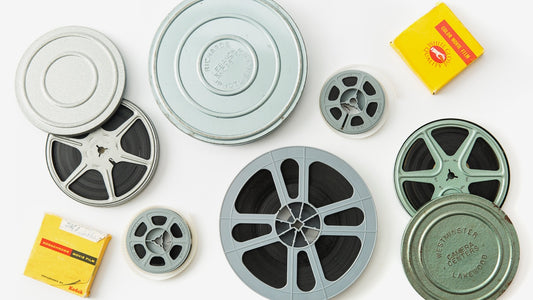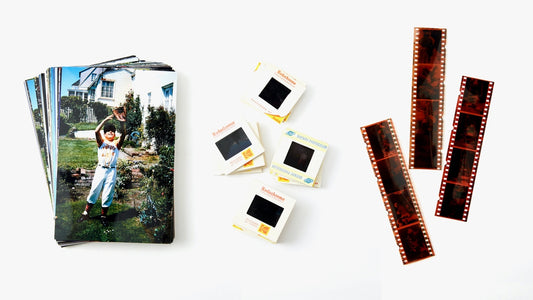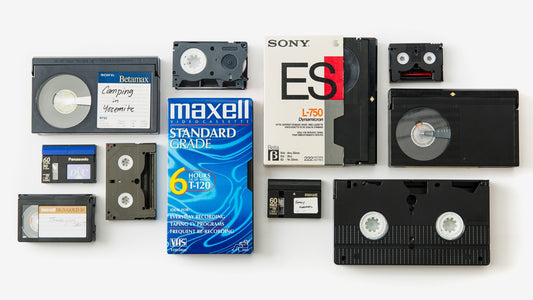Your Super 8 films are a direct link to the past, but right now, they're trapped on aging reels. With each passing year, they risk being forgotten or degrading beyond repair. The best way to protect these memories is to digitize them. This turns your family’s stories—the big events and the quiet, everyday moments—into something you can share with a single click. But you need a partner you can trust with these precious films. This guide is here to help you compare your options and choose the best Super 8 digital service for your family’s archive.
Key Takeaways
- Act Now to Stop Film Degradation: Converting your Super 8 reels to digital is the only way to permanently protect them from fading, warping, and breaking. This process creates a lasting copy of your family’s history that you can easily share.
- Prioritize Quality Scanning and Handling: When choosing a service, look for key features like frame-by-frame HD scanning and careful film cleaning. The best value comes from a company that treats your irreplaceable films with expert care, not just the one with the lowest price tag.
- Make a Backup and Plan a Movie Night: Once you receive your digital files, immediately save a copy to a cloud service and an external hard drive. Then, get ready for the fun part—sharing the videos with loved ones and reliving those cherished moments together.
Understanding Super 8 Film
Before you can preserve your family’s filmed memories, it helps to know a little about what you have. Super 8 film is a specific format with its own unique characteristics, and getting familiar with the basics will help you appreciate what’s stored on those little reels. This knowledge is the first step in bringing your family’s history back to life and making informed decisions about how to best protect those moments for the future. From identifying the format to understanding how much footage you actually have, you'll be better prepared for the journey of digitizing your precious films.
Key Differences: 8mm Film vs. 8mm Videotapes
It’s easy to get 8mm film and 8mm videotapes confused, but they are completely different formats that require different approaches to preservation. If you have small plastic reels with sprockets on the side, you’re holding 8mm or Super 8 film. These are thin strips of photographic film that capture individual frames, and you would have needed a projector to watch them. On the other hand, if you have small cassettes labeled Video8, Hi8, or Digital8, you have 8mm videotapes. These use magnetic tape to record video, much like a VHS tape. While both formats hold precious memories, the process to digitize videotapes is distinct from converting film. Knowing which one you have is the first step toward getting them preserved correctly.
How Much Footage Is on a Reel?
One of the most common questions we get is, "How long are my movies?" You can get a good estimate just by measuring the diameter of your film reels. The most common size is the 3-inch reel, which holds 50 feet of film and runs for about three to four minutes. You might also have larger 5-inch reels (200 feet) or even 7-inch reels (400 feet), which contain significantly more footage. Knowing the reel size gives you a rough idea of the runtime, which is helpful when you're getting ready to digitize your film collection. It helps you organize your reels and understand the scope of your family’s cinematic history before you send it in for conversion.
The Comeback: Modern Super 8 Cameras
While you might think of Super 8 as purely a vintage format, it has seen a surprising resurgence in recent years among filmmakers and artists drawn to its distinct, nostalgic aesthetic. Some companies have even developed new cameras that blend the classic feel of film with modern technology. For example, the Codex Super8 camera allows creators to shoot on real 8mm film while offering digital features like a built-in monitor and sound recording. This renewed interest proves the timeless appeal of the Super 8 look and feel, making the memories you have on your old reels even more special and culturally relevant today. It’s a beautiful reminder that what you’re preserving is a true piece of art.
Understanding Film Stock: Negative vs. Reversal
Your Super 8 reels are likely one of two types: reversal or negative film. Reversal film was the most common choice for home movies because it could be put directly into a projector to be viewed as a positive image—what you shot is what you saw. Negative film, as the name suggests, captures an inverted image that must be processed and color-corrected to be seen properly. While it required an extra step, negative film often captures a wider range of detail and color information. Don't worry if you don't know which type you have. A professional film transfer service can expertly handle both, ensuring the final digital files look vibrant and true to life, regardless of the original film stock.
Why Digitize Your Super 8 Film?
Those little reels of Super 8 film hold some of your family's most treasured moments, from birthday parties to wedding days. But finding a working projector to watch them can be a challenge, and the film itself won't last forever. Converting your Super 8 reels to digital files is the best way to protect those memories and make them easy to enjoy again. It bridges the gap between your family's history and today's technology, ensuring those moments are never truly lost.
Keep Your Memories from Fading Forever
The tough reality is that physical film degrades over time. The vibrant colors from that family vacation in the '70s can fade to muted tones, and the film itself can become brittle and prone to breaking. Each time you run a reel through an old projector, you risk scratching or damaging it permanently. A professional film transfer service stops this aging process in its tracks. By creating a high-quality digital copy, you get a permanent, stable version of your home movies that won't fade, warp, or tear. It’s the modern-day equivalent of a fireproof safe for your most precious memories.
Watch and Share Your Films, Anywhere
Once your films are digitized, you can finally watch them without hauling a clunky projector and screen out of the closet. Your memories will be available as simple video files that you can watch on your computer, smart TV, or even your phone. Sharing them becomes just as easy. Instead of mailing heavy film reels, you can send a link to your sister across the country or post a clip on social media for the whole family to see. You can receive your new digital keepsakes on a thumb drive, DVD, or through a secure cloud link, giving you endless options for reliving and sharing those moments with the people you love.
How to Choose the Best Super 8 Digital Service
Picking the right service to handle your family’s Super 8 films can feel like a big decision. After all, these aren't just reels of plastic; they're irreplaceable moments. To make the right choice for your memories, focus on a few key areas that separate a great service from a mediocre one.
What to Look for in Scan Quality
The whole point of digitizing your films is to see them in beautiful clarity, so scan quality is at the top of the list. Not all conversions are the same. Look for a service that offers high-definition scanning, like 1080p or even 2K, to capture the rich detail in every frame. A professional film transfer will ensure your home movies look sharp and vibrant on modern screens. Think of it as future-proofing your memories so they can be enjoyed for generations to come without looking blurry or pixelated.
Comparing Price vs. Value
While it’s tempting to go for the cheapest option, it’s better to think in terms of value. The price tag often reflects the quality of the equipment, the care taken during the process, and the final product you receive. Compare what’s included in the cost. Does it cover film cleaning, minor repairs, or different digital delivery options? A slightly higher price might mean you’re getting a much better-quality scan and a more reliable service. You’re not just buying a digital file; you’re investing in the preservation of your family’s history.
Understanding Service Models: Per-Item vs. Kit-Based
As you compare services, you'll find they generally fall into two camps: per-item pricing or kit-based systems. With a per-item model, which is how we handle things at YesVideo, you pay for each individual reel you want to convert. This approach is incredibly straightforward and works well whether you have a few special reels or a few dozen, because you only pay for what you actually send. On the other hand, some services offer a kit-based system where you purchase a box for a flat rate and fill it with your media. This can be a good deal if your collection perfectly fills the box, but you might end up paying for unused space. Understanding your own collection size will help you decide which model offers the best value for your film transfer project.
How Long Will It Take to Get Your Films Back?
Sending your precious films away can be a little nerve-wracking, so knowing when to expect them back is important. Most professional services take a few weeks to digitize your films by hand. A typical turnaround time is about three to four weeks from when they receive your order. This gives technicians the time to carefully clean, scan, and review your footage. A company that provides tracking and regular email updates can offer great peace of mind, letting you follow along as your memories make their digital debut.
Expedited and Rush Processing Options
Sometimes, you need your memories back on a tighter schedule, especially with a big family reunion or anniversary party just around the corner. If waiting a few weeks isn’t an option, look for a service with expedited processing. Many companies offer rush services for an additional fee to move your order to the front of the line. For instance, some services like Legacybox can cut the standard turnaround time down to just a couple of weeks or even 10 business days. When you’re comparing options, always check for these faster timelines to make sure your newly digitized home movies are ready for their big debut.
Why Good Customer Support Matters
Good customer support can make all the difference, especially when you’re trusting a company with one-of-a-kind memories. Before you commit, check out their support options. Is there a phone number or email you can easily find? A responsive and helpful customer service team shows that a company stands behind its work and cares about your experience. Reading a few customer reviews can also give you a good sense of how a company treats its clients when questions or issues arise.
Checking for Extra Features and Add-Ons
Sometimes it’s the little extras that make a service stand out. Many older films may have collected dust or become brittle over time. Some companies offer film cleaning and minor repairs as part of their process, which can dramatically improve the final video quality. Also, consider how you want to receive your digital files. Look for flexible options like a USB drive, a digital download, or a DVD. Having choices makes it easier to store, edit, and share your memories with your entire family.
Services for New Filmmakers
It’s not just vintage family reels getting a second life; a new generation of creators is picking up Super 8 cameras for their unique, nostalgic look. If you’re one of them, you’ll need a plan for developing and digitizing your new footage. Some companies, like Pro8mm, offer convenient packages that bundle film stock with processing and scanning services. However, the most critical step is the final scan, which turns your physical film into a high-quality digital file ready for editing and sharing. Whether your reel captures a wedding or your latest creative project, a professional film transfer ensures every frame is captured in sharp, high-definition detail. This gives your work the polished, professional finish it deserves and makes it easy to share your vision on modern screens.
Our Top 7 Picks for Super 8 to Digital Services
Choosing the right service to handle your precious home movies can feel like a big decision. You want a company you can trust to treat your films with care and deliver a beautiful digital copy you can enjoy for years. To help you find the perfect fit, I’ve put together a list of some of the best Super 8 to digital conversion services out there, each with its own unique strengths.
1. YesVideo
If you’re looking for a trusted leader in the industry, YesVideo is a fantastic choice. With over 20 years of experience, they have a proven track record of safely digitizing millions of memories. They offer high-quality film transfers for 8mm, Super 8, and 16mm reels, all processed by hand at their secure facility in the USA. What I appreciate most is their commitment to quality and security; you get peace of mind knowing your one-of-a-kind films are in good hands. They return your digital memories on your choice of DVD, a custom USB, or through a convenient cloud account, making it simple to watch and share with family.
2. Video Conversion Experts
For those who prioritize the highest possible image quality, Video Conversion Experts is a top contender. They stand out by offering professional-grade scanning at resolutions up to 4K, which captures incredible detail from your original Super 8 reels. This is a great option if you plan to watch your home movies on a large screen or want to do some editing yourself. Their focus on top-notch conversion ensures you get a digital file that’s as crisp and clear as possible, preserving the cinematic quality of your original films for the future.
3. ScanCafe
ScanCafe specializes in converting 8mm and Super 8 films, making them a focused expert in handling these specific formats. Their service is designed to make your memories accessible again, turning old reels into digital files that are easy to watch on any modern device. They offer a unique process where you can review your scanned images online and discard any you don’t want before paying, giving you more control over the final product. If you have a large collection of films, their 8mm film to digital service is a solid choice for its blend of quality and value.
4. Legacybox
If you love a simple, all-in-one solution, Legacybox is designed for you. Their process is incredibly straightforward: they send you a crush-proof box with pre-paid return shipping and everything you need to safely pack your films. You just fill it up and send it back. This approach takes the guesswork out of the process, which is perfect if you’re feeling a bit overwhelmed. Legacybox focuses on making the conversion of 8mm and Super 8 as easy as possible, delivering your digitized memories on a thumb drive, DVD, or via a digital download.
5. Just8mm
As their name suggests, Just8mm is a specialist with a deep focus on 8mm and Super 8 film formats. This specialization means they have extensive experience handling the specific needs and potential issues of these older reels. They offer a range of delivery options for your final product, including DVDs, USB drives, or downloadable digital files, giving you the flexibility to choose what works best for you. Their dedicated service for converting 8mm film is a reliable option for anyone wanting to work with a company that lives and breathes this specific type of media.
6. SouthTree
SouthTree offers a practical and affordable option for digitizing your home movies. They convert films at a 480p resolution, which is a standard definition that’s perfectly suitable for viewing on most TVs and computers. A great feature they offer is manual color correction and image stabilization, which can help improve the look of faded or shaky footage. This makes SouthTree a strong choice if you’re looking for a budget-friendly service that still includes valuable enhancements to make your old home movies more enjoyable to watch.
7. Costco Photo Center
For ultimate convenience, especially if you’re a Costco member, the Costco Photo Center is an excellent choice. You can simply drop off your Super 8 reels at your local store, and they handle the rest. Costco partners with trusted vendors like YesVideo to process the orders, so you can be confident in the quality of the transfer. This option is perfect for busy families who want a simple and reliable way to digitize their memories without having to worry about packing and shipping everything themselves. It combines the ease of a local drop-off with the expertise of a professional lab.
How Much Does Super 8 Conversion Cost?
Understanding how your films get from a dusty box to a digital file can make the whole process feel less mysterious. While every company has its own unique workflow, the basic steps and pricing structures are often similar. Knowing what to expect will help you feel confident as you send your precious memories off for their digital makeover. Let's break down what goes into the cost and what the journey looks like for your Super 8 reels.
What Factors Affect the Price?
The cost of converting your Super 8 film depends on a few key factors. The most significant is usually the length of your film, as most services charge by the foot. Other elements that can influence the price include the scanning resolution you choose (higher resolution often costs more), whether you need your film cleaned beforehand, and any add-ons like color correction or custom editing. Choosing a professional service might seem like a bigger investment upfront, but it ensures you get high-quality results and peace of mind, which is priceless when dealing with irreplaceable memories.
How Film Length and Type Affect Cost
The biggest factor that determines your final cost is the total length of your film. Most conversion services charge by the foot, so the more footage you have, the more it will cost to digitize. Your Super 8 reels likely come in a few standard sizes: a small 3-inch reel holds about 50 feet of film, while a larger 7-inch reel can hold up to 400 feet. While the type of film—whether it's standard 8mm or Super 8—doesn't usually change the price dramatically, the length is what really matters. Understanding this helps you estimate your costs and see why a service that offers clear, per-foot pricing provides the most transparent value for preserving your family’s history.
A Look at Typical Cost Ranges
Pricing can vary quite a bit from one service to another, so it’s wise to compare a few options. You’ll find that many companies structure their pricing based on film length. For example, some services start their pricing at around $0.34 per foot. Other companies offer an all-in-one box price where you can send a set number of tapes or reels. The final cost reflects the level of service, the technology used, and the care taken with your films, so you’re paying for both the digital files and the expertise that protects your originals.
Your Film's Journey: The Step-by-Step Process
Once you’ve chosen a service, the process is usually quite simple on your end. You’ll start when you pack your old films and ship them to the company’s lab. From there, the experts take over. Technicians carefully inspect and clean your reels before the transfer. At some labs, they splice smaller reels onto larger ones to ensure a smooth, continuous scan. Then, their team digitizes your items by hand, often using frame-by-frame scanners to capture every detail. This hands-on approach ensures your delicate, one-of-a-kind films are handled with the utmost care from start to finish.
How You'll Receive Your Digital Videos
After the scanning is complete, you get to the best part: receiving your newly digitized memories. Companies offer several ways to get your files back. You can typically get your digital videos on a thumb drive, a set of DVDs, or through a secure cloud account for easy downloading and sharing. Once your 8mm films are digitized, you have so many more options for enjoying them. Instead of being stuck on a projector, your family memories are ready to be watched on your TV, computer, or phone and shared with loved ones anywhere in the world.
Quality and Care: What Happens to Your Film?
Handing over your precious family films can feel like a big deal. You’re not just sending away old reels; you’re trusting someone with irreplaceable memories. Understanding how a professional service handles your film and what kind of quality you can expect will give you peace of mind and help you choose the right company. The best services treat your originals with the utmost care while using top-tier technology to create a digital copy you’ll love watching.
From the moment your films arrive, they should be in good hands. A quality service will inspect, clean, and carefully scan each reel to produce the best possible digital version. It’s not just about getting a video file back; it’s about getting a clear, vibrant, and lasting representation of your original footage. Let’s walk through the key steps in the process so you know exactly what to look for.
Why Frame-by-Frame Scanning Is a Must
Think of your Super 8 film as a long strip of tiny individual photos. The best way to digitize it is with frame-by-frame scanning. This method captures each of those tiny photos as a high-quality digital image before stitching them together into a smooth, stable video. It’s a meticulous process that ensures every detail is preserved, resulting in a sharp and flicker-free digital movie. This is a huge step up from older methods where a film was simply projected onto a surface and re-recorded, which often led to lower quality and distortion. When you convert 8mm film to digital, this is the gold standard you should look for.
Choosing the Right Resolution for Your Films
Resolution refers to the clarity and detail of your digital video. Most conversion services will offer at least a high-definition (HD) option, which looks great on modern TVs, computers, and smartphones. Some may also provide standard definition (SD), which is a bit lower in quality but can be a more budget-friendly choice. For the absolute best quality, you might see options for 2K or 4K scanning. While HD is perfect for most families who just want to watch and share their memories, higher resolutions can be a good investment for archival purposes, ensuring your films look fantastic on whatever viewing technology comes next.
Will They Clean and Repair Your Film?
Over the decades, your film reels have likely collected some dust and may have become brittle. A crucial step in any professional digitization process is preparing the film for scanning. Technicians will carefully inspect your reels by hand, cleaning off any dust, mold, or grime that could show up in the final video. They’ll also repair any broken splices or weak points in the film to ensure it can run smoothly through the scanner without being damaged. This preparation makes a massive difference in the final quality, giving you a much cleaner and more enjoyable viewing experience.
How Your Original Films Are Kept Safe
It’s completely normal to worry about what happens to your original films once you send them off. Reputable companies understand the sentimental value of your reels and have strict protocols to keep them safe. At YesVideo, for example, every order is processed by hand in the USA. This hands-on approach ensures your memories are treated with personal care, not just fed into a machine. The goal of a professional film transfer is to create a beautiful digital copy without harming your originals. Once the process is complete, your original reels should always be returned to you along with your new digital files.
Shipping Protection and Guarantees
It’s completely understandable to feel a bit anxious about mailing your irreplaceable films. This is why checking a company's shipping protection policies is a crucial step. A reputable service will offer assurances to give you peace of mind. For instance, some companies provide a financial guarantee if your package gets lost during shipping, like Legacybox’s offer of “Added-Safety Protection.” This kind of policy shows that a company truly understands the sentimental value of your memories and is committed to protecting them. When you choose a service, look for one that provides clear tracking and a safety guarantee, as it’s a strong sign that they take the security of your order seriously from start to finish.
Post-Conversion Storage Policies
After your films are digitized, the journey isn't quite over. It's important to know the company's policy on storing your new digital files and your original reels. Services handle this differently; some may store your digital files for free for a limited period, like 30 days, after which you might need to pay for a storage contract to keep them accessible. If you don't act within their timeframe, your files could be deleted. This highlights the importance of having a plan to back up your digital files immediately. Understanding these post-conversion policies ahead of time helps you avoid any unwelcome surprises and ensures you have a clear plan for safely archiving your new videos.
What to Do with Your New Digital Videos
Getting that email or package with your newly digitized Super 8 films is such an exciting moment. All those memories, once trapped on fragile reels, are now free! But after the initial excitement, you might wonder, "What's next?" The great news is that once your films are digitized, you have a wealth of options for preserving and sharing those precious memories. Thinking through a few key steps will help you protect your new digital files, make them shine, and share them with everyone you love. Let’s walk through how to make the most of your family’s cinematic history.
How to Safely Store Your Digital Files
First things first, let's make sure your digital videos are safe for the long haul. Physical media can get lost or damaged, and digital files aren't immune to disappearing if a hard drive fails. A good rule of thumb is to keep at least two copies of your files in different places. You can store one copy on a physical device, like an external hard drive or a high-capacity USB drive. For your second copy, consider using a cloud storage service like Google Drive, Dropbox, or the MemoryCloud account that comes with your YesVideo order. This gives you an off-site backup that you can access from anywhere, protecting your memories from accidents like fire or flood.
Quick Edits to Make Your Videos Shine
Your digitized films will already look great, as professional services often include extras like color correction and other enhancements. But you can add a few personal touches to make them even more special. You don’t need to be a Hollywood director to make simple edits. Free, user-friendly software like iMovie on a Mac or the Photos app on Windows can do the trick. You can trim out the shaky bits at the beginning of a clip, add simple title cards to note the year or event, or even combine several short clips into a "greatest hits" reel. Adding a soft, instrumental music track can also transform a silent film into a moving trip down memory lane.
The Best Ways to Share Your Memories
This is the best part: sharing your rediscovered moments with family and friends. With digital files, it’s easier than ever. You can upload your videos to a shared online album and send a single link to the whole family, allowing everyone to watch from any device with an internet connection. For a wider audience, you could post short, fun clips on social media. And of course, there’s nothing quite like a family movie night. You can easily play your digital videos on a smart TV from a USB drive or by streaming them from your computer. It’s a wonderful way to gather everyone together and let the stories and laughter unfold.
Making Your Final Decision
Choosing a service to handle your family's films can feel like a huge decision. After all, these aren't just reels of plastic; they're irreplaceable moments with people you love. You want to make sure they're in safe hands and that the final result is something you'll be proud to share. The good news is that you don't have to guess. By thinking through a few key points, you can confidently pick the right service for your precious memories. Let's walk through exactly what to consider so you can feel great about your choice.
First, Figure Out What You Really Need
Before you start comparing services, take a moment to get clear on what you're looking for. Start by identifying what kind of film you have—is it 8mm, Super 8, or 16mm? Knowing this will help you find a service that specializes in your specific format. Then, think about the end goal. Do you want your digital files on a USB, a DVD, or saved to the cloud for easy sharing? Some services also offer extras like color correction or editing tools. Making a quick list of your must-haves will make it much easier to find a film transfer service that checks all your boxes and saves you time in the long run.
Finding the Right Balance Between Quality and Cost
It’s tempting to just go with the cheapest option, but when it comes to preserving memories, price isn't the only factor. Think of digitization as an investment in your family's history. Higher-quality, frame-by-frame scanning will cost more than a basic transfer, but it will also produce a much clearer and more vibrant video. Look for a service that is transparent about its pricing and what’s included. A company that handles the entire process, from cleaning your film to providing a secure way to view your digital files, offers incredible value and peace of mind. This convenience ensures your films are handled by experts from start to finish.
Don't Skip the Customer Reviews
Reviews are your best friend when vetting a digitization service. They give you a real-world look at what you can expect. Pay close attention to recent reviews, as they reflect the company's current performance. Look for comments that mention the quality of the final video, the turnaround time, and how the company communicated throughout the process. Did they handle the original films with care? Were customers happy with the support they received? Reading through YesVideo reviews, for example, can show you what other families have experienced, helping you find a company that’s trusted and reliable.
What to Do With Your Original Reels
Once your digital files are safely backed up, you’ll have your original reels back in your hands. While you now have a permanent digital copy, these physical films are still precious family artifacts. Taking good care of them ensures the original version of your history remains intact as a keepsake. And if you’re curious about what’s on a reel you haven’t digitized yet, there are a few ways to get a sneak peek without tracking down a working projector.
How to Properly Store Your Film at Home
To keep your original reels from deteriorating further, proper storage is essential. The ideal spot is a cool, dry place with a stable temperature, like an interior closet—avoid attics and basements where humidity and temperature can fluctuate dramatically. Sunlight is film’s enemy, as it can cause the colors to fade, so keep them tucked away in the dark. It’s also a great idea to move them out of their original cardboard boxes, which can break down and release acids over time. Instead, invest in special acid-free, archival containers to give them the best possible protection.
Alternative Ways to View Film Without a Projector
If you’ve found a mystery reel and can’t wait to see what’s on it, you don’t necessarily need a projector. For a quick look, you can use a high-powered magnifying glass or a jeweler's loupe. Carefully pull out a small section of the film and hold it up to a light source to see the tiny individual frames. Another option is to find a vintage film editor, a small device that lets you hand-crank the film past a light and view it on a tiny screen. These methods are a fun way to get a glimpse, but they won’t let you actually watch the movie.
While these tricks can satisfy your curiosity, the best way to truly see, share, and preserve your footage is through professional digitization. Sending your reels for a film transfer is the only method that creates a high-quality, watchable movie from your original films. It’s the safest and most effective way to unlock the memories stored on each reel, turning them into digital videos that your entire family can enjoy on any modern screen. This ensures your family’s stories are not only seen but also preserved for future generations.
Related Articles
- Convert 8mm Film to Digital: DIY & Pro Guide – YesVideo
- Convert 8mm to Digital: The Ultimate Guide (2023) – YesVideo
- 8mm to DVD: Top Conversion Services & DIY Guide – YesVideo
- 8mm to Digital: DIY vs. Pro Services Compared – YesVideo
- Convert 8mm Film to Digital Near Me: 6 Top Services – YesVideo
Frequently Asked Questions
Will I get my original film reels back? Yes, absolutely. Any reputable conversion service understands that your original films are irreplaceable. Their job is to create a high-quality digital copy for you to enjoy, not to keep your originals. Once the digitization process is complete, your Super 8 reels will be carefully packaged and returned to you along with your new digital videos.
What if my films are really old and don't have sound? That’s perfectly normal, and it’s exactly what professional services are equipped to handle. Most Super 8 home movies were made without sound, so you're not missing anything. Technicians will also inspect your film by hand and can often clean away decades of dust or repair old, brittle splices to ensure the smoothest possible scan and the best-looking final video.
Why should I pay for a service instead of just recording the film with my phone? While you can certainly try recording a projection with your phone, the quality difference is night and day. A professional frame-by-frame scan captures a crisp, clear, and flicker-free image from each tiny frame of your film. This process avoids the distortion, poor lighting, and shaky results of a DIY setup, giving you a beautiful digital video that truly honors the original memory.
Is it better to get my videos on a USB, DVD, or cloud link? This really comes down to how you plan to use your videos. A cloud link is fantastic for instantly sharing with family members, no matter where they live. A USB drive is great for plugging directly into a smart TV or computer and for creating your own backups. DVDs are a solid option if you or your relatives are most comfortable using a DVD player. Many people choose both a physical format and cloud access for the most flexibility.
How long does the entire process usually take? While it can vary between companies, a good rule of thumb is to expect a turnaround time of about three to four weeks from the moment the service receives your films. This window gives the technicians enough time to carefully inspect, clean, scan, and review your footage by hand, ensuring they deliver a high-quality result that you’ll be excited to watch.





